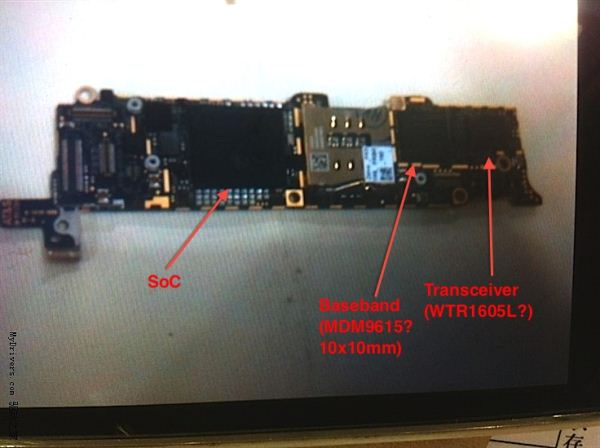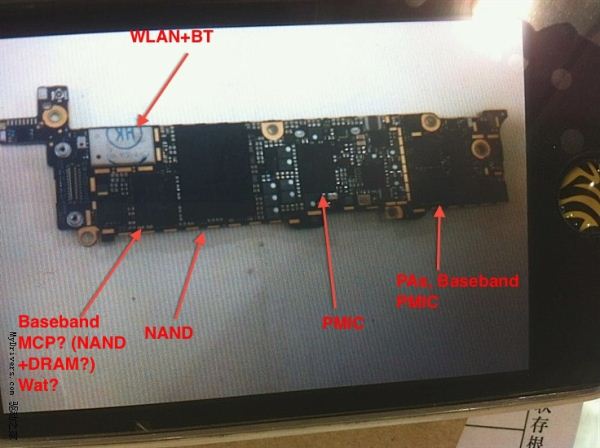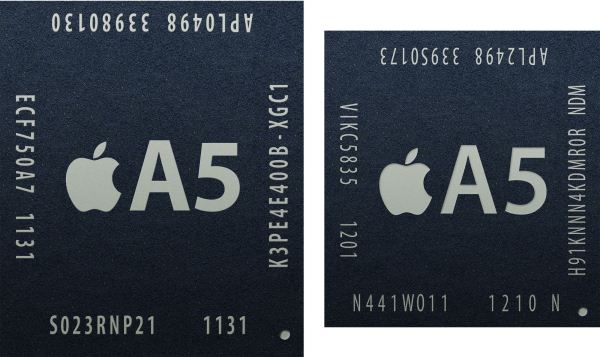Preparing for the iPhone Next: Rumors Analyzed
by Brian Klug & Anand Lal Shimpi on August 27, 2012 9:40 PM EST- Posted in
- Smartphones
- Apple
- Mobile
- iPhone
The SoC: 32nm A5R2?
So much of any new iPad/iPhone release is tied to the SoC. Apple remains one of the only handset designers that aggressively specs its own SoC rather than picking up an off the shelf part. As of late, Apple has used its control over its own SoC architecture to better match its chip architectures to the needs of its high resolution displays. Apple continues to produce its custom-designed SoCs at Samsung, although it's likely that Apple will consider other foundries at the 20nm node.


Rumored upcoming PCB, annotations ours
Most early looks at the next iPhone's internals show no silkscreened part numbers on the SoC. We've already seen blurry photos of the suspected upcoming PCB leak, though they're far too low quality to make out any chip markings. Given Apple's history, it's likely we'll see a 32nm LP (HK+MG) variant of the A5 SoC used in the iPhone 4S - perhaps at higher clocks. The move to a smaller process node should bring about a tangible increase in battery life. Depending on the workload, the iPhone 4S could burn more power than the iPhone 4 thanks to its beefy CPU + GPU combination. The move to 32nm could easily offset this penalty.
We've seen Apple experiment with Samsung's 32nm LP process in the past. Both the current generation Apple TV and the iPad 2,4 use a 32nm A5. In the case of the iPad 2,4, we saw a huge increase in battery life as a result of the move to 32nm. Some of the gains in battery life in the iPhone are likely to be offset by higher CPU/GPU clocks, but this is still the most likely approach for Apple this generation.

Original A5 (45nm, S5L8940, left), A5R2 (32nm, S5L8942, right)
As we mentioned back during our review of the iPad 2,4, it makes sense to test a new/unfamiliar process on a low volume part. By shipping 32nm A5 SoCs into some iPad 2s and the Apple TV (a hobby product), Apple could ride the 32nm yield curve up without adversely impacting shipments of its key money makers. With Samsung's 32nm LP process likely seeing much better yields now, it's time to deploy it in the next iPhone. Given much of the competition has moved to TSMC's 28nm process, Apple must remain competitive on the process node front as well. Shipping a 45nm SoC at the end of 2012 simply doesn't make sense. Although the current legal battles with Samsung could impact the relationship on the foundry side, simply switching to Global Foundries or TSMC is easier said than done. I would expect Apple to go through the same careful transition between Samsung and any other foundry as it did when it introduced the first 32nm A5s into the mix. The current expectations here are that we'll see Apple look at TSMC at the 20nm node.
With process node pretty much guaranteed, there's the question of CPU and GPU architectures.
Since the release of the original iPad, Apple has used the spring to introduce new SoC architectures in the iPad and later waterfall them down to the iPhone in the summer/fall. The A5X in the 3rd generation iPad however is still built on Samsung's 45nm LP process and is huge as a result of integrating four PowerVR SGX543 cores and implementing a 4 x 32-bit memory interface. The A5X needed the GPU power and memory bandwidth to drive the new iPad's retina display, but that power would be largely lost on the next iPhone.
The new iPhone is expected to have a 640 x 1136 resolution, thanks to its taller 4-inch display, but that's only 18% more pixels than the current iPhone 4S. A doubling of memory bandwidth and GPU compute horsepower would seem a bit excessive for current workloads. A ~20% increase in GPU clock speed, and faster DRAM would be enough to maintain current levels of performance on the higher resolution display.
Apple decoupled major cellular architecture and CPU architecture shifts in the past (e.g. iPhone 3G/3GS transition), which lends credibility to the idea of a move to A15 next year with the 4th gen iPad and sticking with the dual-core A9 design for the next iPhone. There's also the fact that TI is expected to be one of the first to bring an ARM Cortex A15 based SoC to market, and even it hasn't demonstrated an OMAP 5 running at shipping CPU clocks yet. I don't doubt that it's possible to ship an A15 based SoC before the end of the year, but based on the demos we've seen thus far, it seems highly unlikely to see one shipping in Q3. Apple doesn't like to be overly risky on the component front. There's nothing worse than a poorly yielding or otherwise problematic chip holding up shipments of one of your biggest revenue generators.










131 Comments
View All Comments
WaltFrench - Wednesday, August 29, 2012 - link
Overall, this was a very interesting scan of the issues.But battery life is a huge issue for some users, and important to all. So I was a bit disappointed that after all that GREAT analysis of each of the major subsystems, the contributions to battery life weren't discussed.
LTE is said to be especially battery-hungry in recent chips. Do the hypothesized baseband chips indeed gobble lots of juice? Approximately what milliwattage? And how about the expected screen tech? Screen efficiency was a major hit to power conservation on the Retina iPad; what can be expected here?
And while iOS 6 is still NDA at best, Apple's been dealing with multi-core for a long time. Any credible guesses about the software's ability to downclock the whole CPU and/or cycle individual units on and off, based on previous iOS info?
crankerchick - Wednesday, August 29, 2012 - link
People always say, "I hate to bother you but..." and then proceed to bother you. "I hate to convince you, but..." and then proceed to inconvenience you. "I don't mean to be an a jerk it..." and the proceed to be a jerk. Don't say you don't usually like to engage in rumor mill and then basically lend your advice to what rumors make sense and which ones don't. I respect our conclusions and reasoning, and even think you are probably spot on, but I do think your article kind of does the "I hate to contribute to the rumor mill but..." and the contribute to the rumor mill, albeit backed by some sound analysis. I think you are in a dangerous arena for credibility if you travel down this road.That said, I hope you will touch on your thoughts and how they measured up once the device is announced. I have no doubt some others will do this for you and then comment on any areas where you were wrong.
Toadster - Wednesday, August 29, 2012 - link
LOL - I see what you did there!hopefully it's not a 12" cube phone ;)
eanazag - Wednesday, August 29, 2012 - link
I am guessing they will include 1GB of RAM as they did in the iPad 3 so that developers will have a consist playing field going forward.What remains a question is whether they will further upgrade the camera. I think they will leave the camera untouched. The front facing camera could use a boost - especially with the Facetime over cellular coming.
Better battery life compared to the 4S would be very welcome. I have a 4 and won't touch the new iPhone unless it has 4G. I might even jump ship. I have been getting by with my 4G hotspot, but that is a pain. The charge on the hotspot is nowhere near as long as the phone.
Honestly, I have a 4 and am still pretty happy with it. I do feel at times the single core is holding back performance. My biggest wants are addressed with turn-by-turn and 4G. The turn by turn still needs to prove itself.
I am posting this from my iPad.
I am very excited to see MS entering the tablet hardware business with the Surface. I really think Dell and HP have failed miserably with their hardware thus far. They could have done a better job on Windows 7 tablets. I thought MSI took the best approach with AMD's processor and 4GB of RAM. Atom's experience on the graphics side is horrid. HP/Dell knuckleheads trying to push 2GB max devices still running Windows 7. It is still Windows 7 and the best experience is in the 4GB or more arena. Windows 8 and Surface make a lot of sense; there is one scenario that I believe Apple is beat in the tablet space and that is docking. I have a company full of users who have laptops with 2 monitors, a mouse, and keyboard. No mouse support is just ignorant on iOS and no USB drive support. I think Apple has no desire to include mouse support because the iPad may then cut into its laptop sales.
Origin64 - Thursday, August 30, 2012 - link
First of all, how does moving the headphone jack to the bottom make sense? I like to listen to music with my phone in my pocket. Were I to buy the new iPhone, which I do admit is unlikely, I would have to do that with the phone upside down.Secondly, no 1280*720 is a dealbreaker. I want 720p movies at native resolution. Same goes for NFC. I don't see myself using it in the coming months, but I might just want to have it in two years.
5Ghz wifi support is good news, although I think dual or triple channel 2.4 would be good enough for me, especially as there's usually a layer of concrete between me and my routers.
Lastly, battery life. Now I know battery life on the iPhone has always been impressive, and the move to a smaller node should emphasize that even more, but why not capitalize as much as possible on this advantage and release the iPhone with 1800+ mAH. Maybe even 2000. Surely it can be done, and it would open a whole new group of customers to Apple: those that want to charge their phones as sparsely as possible. There's plenty demand for it.
Super56K - Friday, August 31, 2012 - link
I doubt there's serious demand for crazy battery life in a smartphone. It's become ingrained in us to top off our phones each night to have a full charge for the following day. Some flagship phones already give you 2 days of moderate use.sives - Thursday, August 30, 2012 - link
Our research at Hoverkey (http://bit.ly/SWQGt7) has thrown up an interesting new twist on the iPhone 5 NFC debate set off by your article. Apple was granted a key patent last year that describes a novel design method for embedding an NFC antenna within a screen display aperture or even in the LCD screen module.This means that the iPhone 5 could have a metal unibody case AND a front-facing NFC antenna. Usability-wise this would make a lot of sense. It's much easier (and more intuitive) for a user to place their iPhone 5 against another NFC device front-first, because their hand is holding the device from the back.
OTD - Friday, August 31, 2012 - link
I agree with sives and it was a major flaw in the original article to assume that the NFC radio frequency has to be emitted from the back of the phone.Apple engineers always try to mimic human actions and behaviors when designing user interface. When you meet your friend, you hug with your friend face-to-face, not back-to-back. Therefore, if you want to send a iTune gift to your friend through the NFC interface, you two 'bump' your phones in a natural face-to-face way.
The position of the reader is consistent with the one shown in their patent on NFC.
Some one in Japan pointed out that the component in the "leaked photo" was similar to a RFC reader supplied by Toppan TDK Label:
http://www.toppan-tl.co.jp/en/sp/nfc.html
Apple may not use the same reader but the design concept could be similar. The small but thick 1-loop NFC antenna on the front. Then next layer some magnetic shielding material is required to boost up the reading distance. Behind the shielding material will be the NFC RF controller circuit board. The last one is the metallic EMI cover we saw from the photo. The small antenna loop should be able to achieve 2 to 4 cm reading distance for peer-to-peer transactions and card-mode emulation.
iwod - Thursday, August 30, 2012 - link
Been going through my head, that A6 or what ever it will be called to only have a die shrink mentioned by Anand. This simply wouldn't make sense as the performance gap will be so wide between its competitors. Apple manages to fit a 110mm2 die size A5 inside 4S, the die shrink version tested with Apple TV is only 63mm2. Surely Apple could use a little more Die Space for performance?Having similar, or zero improvement on graphics doesn't make sense either. With 30% more pixel to work with it will essentially be a downgrade rather then upgrade.
Apple dont use Krait, and QualComm doesn't offer PowerVR based GPU if even Apple liked. I took a few look and research on the web, and it seems very likely Apple will take a similar approach with TI OMAP4470. It uses a standard Cortex A9 as with Apple 's Ax SoC, uses PowerVR 544 which is a little bit more powerful then PowerVR 543 MP2. It also add featues such as CGPU which is like a special GPU for GUI, and reduce the power consumption during normal usage by 10x compare to a normal PowerVR GPU. There is also 2 Cortex M3 Core to help with basic operation like Phone Calls.
Even if Apple didn't licenses the design to use for their own. or buying the chip directly from TI, a similar approach could be done with a bit more R&D.
Since TI OMAP4470 is available soon enough, This sounds like a perfect example of what is possible or Apple A6.
gunblade - Thursday, August 30, 2012 - link
I have friends working in the SOC team and from what I heard silicon was already back in the lab before the new iPad launched. Given the schedule, 9 months should be enough for them to get most of the validation done. If there is no extra spin needed on the silicon, I think it is highly likely that they will go with Cortex A15 based A6 chip. And according the hearsay, it might be the first Rogue based mass production chip.